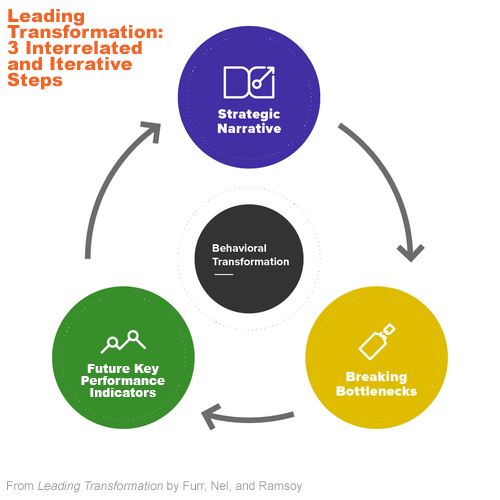11.09.18
Take Charge of Your Company’s Future

HOW CAN WE BREAK FREE of incrementalism, dream bigger, and inspire people to follow us?
The fundamental problem we face say the authors of Leading Transformation, is our tendency toward incremental thinking. That is “to see and act on what is nearby, easy to access, and familiar than what is possible.”
We can’t eliminate our biases, but the authors suggest that to minimize them we take a three-step approach to behavioral transformation in your organization (and life). First, create a strategic narrative about a possible future, second break the decision bottlenecks, and third use key performance indicators—an artifact trail—to create signposts for the road ahead. The authors have a section devoted to each of these, but we’ll touch on them briefly:

Strategic Narrative
We all know stories engage people, but most companies don’t have a meaningful story or if they do, they don’t use it well. The stories you create must be true narratives through the eyes of one person: a story with a narrative arc, characters a conflict, and a resolution. “Narrative works, in part, because it helps us suspend our disbelief and because it creates emotion, belief, and change.”
When it comes to seeing possibilities, science fiction writers have an edge. They urge us to use science fiction writers to write stories of possible futures in your industry. And then present them in comic book format. “Science fiction can be a tool to break the bonds of incrementalism and to imagine other possibilities. The creative genre can help us dream bigger. They provide examples of how science fiction stories help companies do just that.
(Science Fiction: This 1975 video interview with Gerald O’Neill and Isaac Asimov about a manufactured habitat in space inspired Jeff Bezos’ Blue Origin company.)
Breaking Bottlenecks
Creating the story, finding science fiction writers and graphic artists may be the easy part. “Navigating the rat’s nest of motivations, politics., and routines in any big company may be the hardest part.” Applying tools rooted in behavioral science like decision maps and archetypes can help to break bottlenecks. Archetypes can help you understand how to approach the decision makers in your organization. In one example, the legal team was holding up progress out of a desire to protect the company. In the example, Natalie reframed the proposal in a way that the caretaker archetype could appreciate. She suggested the moving forward would help to protect the company in the long run by keeping it relevant.
READ MORE >>
|
|
 About Michael About Michael
Since 1980, Michael McKinney has been the president of LeadershipNow to encourage you to develop the leader in you — to become an active participant in shaping your future and the future of others. In 1980 he also founded M2 Communications as a way to manufacture and develop tools to improve your performance and enjoyment of life through the use of educational web sites, articles and multimedia presentations. He is also the publisher of Foundations Magazine—a personal development e-zine—and is the president of the CenturyOne Foundation—a non-profit organization that promotes biblical archaeology, historical and biblical research, lectures and publications on subjects pertaining to the time of the first century C.E./A.D.
|
|
|
|